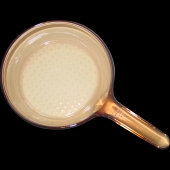Yeah. When I first got interested in RMHs, I looked into making an RMH-powered glass furnace.
The long and the short of it is that it would be much more effort than it's worth. To cook glass from its constituent ingredients requires a consistent temperature up around 2200 C. To simply blow glass, a temperature in the neighbourhood of 1950 C is required. *see edit below*
In addition, the burn environment would likely be so dirty that it would probably affect the quality of the glass.
How do I know this, you might wonder? My much better half is a glassblower and engraver. We have had many conversations where, thinking I have the problem licked, we suss out my ideas, and then she points out all the holes I had overlooked.
RMHs are great for burning small quantities of fuel at temperatures usually reserved for out-of-control chimney fires, and then trapping that heat for slow release.
Glass furnaces, and smelting furnaces, have different requirements, including reaching and sustaining extreme temperatures for long periods of time. Some glass furnaces are constantly up to temperature, as in the case of many shops or institutions that host many glassblowers, because not only does attaining high temperatures and cooling down again take a great deal of time, heating and cooling repeatedly is one of the chief sources of degradation in these systems.
I think that a furnace using RMH principles would no longer be an RMH, though it might have some rockety properties.
The reason natural gas or propane are typically used is because of cost, transportability, energy density, and cleanliness of combustion. Another of the benefits of using something other than wood is avoiding the kind of deforestation caused by ancient and traditional glassblowing and smelting processes.
I fully intend to use many of the heat recovery strategies found in RMHs. I think annealers, kilns, biochar retorts (that perhaps scrub the woodgas and direct it back to the combustion chamber), haybox cookers and ovens are all applications to which I could easily put the heat in the exhaust stream.
To be clear, smelting metals and cooking glass require radically different environments. Metals like copper would require a less-demanding setup, owing to a lower melting point.
-CK
EDIT: Sorry, I got some numbers wrong, owing to Celcius versus Fahrenheit conversions. This was taken from a google search:
The plants sell approximately 90 percent of the cullet to glass manufacturers, who mix it with limestone, soda ash and other raw materials. They then melt the mixture by heating it to temperatures of between 1,427 and 1,538 degrees Celsius (2,600 and 2,800 degrees Fahrenheit).
melting point of glass
A human being should be able to change a diaper, plan an invasion, butcher a hog, conn a ship, design a building, write a sonnet, balance accounts, build a wall, set a bone, comfort the dying, take orders, give orders, cooperate, act alone, solve equations, analyze a new problem, pitch manure, program a computer, cook a tasty meal, fight efficiently, die gallantly. Specialization is for insects.
-Robert A. Heinlein

 1
1




 2
2









 1
1





























